Shinjuku Gyoen(Eco Tourism in the world)
https://blogger.googleusercontent.com/img/b/R29vZ2xl/AVvXsEjpWq8OGA8pZQ96N7Z15YhazLz9GvNh23PzgQZqKQYiJ5yBJ1B9TNITX211fdfT9V6iXti7fGGpF8JLUkRn19qFlAIVtcCGA10HXfwKU-jyfPMCK1e21re5RMp78JpwFOxDyfeQ-b9_-BA/s72-c/shinjuku-garden-770x514.jpg
Shinjuku Gyoen(Eco Tourism in the world)
"Shinjuku Gyoen(Eco Tourism in the world)" a park built in the Edo period (around the 17th century until
the 19th century) in the yard of the home of a Daimyou (term landlord at
that time) was named Naito. In 1908, the park became imperial garden that period. Now this park into a public park known as monk witness the Second World War.Park
with an area of approximately 58.3 hectares is divided into several
gardens with different themes, such as Formal French garden,
English-style garden, and a range of traditional-style Japanese-style
garden. There
are various kinds of trees with leaves falling in autumn here, such as
dogwood, tuliptree, platanus, cherry, acer, and of course the ginkgo
tree was coloring this park. To enjoy the typical colors of autumn in this park, we encourage you
to come in early November to early December (for a more beautiful
dogwood tree in mid-late October).
There is no lighting in the park and the park will be closed at 16:30 (last entry only until 16.00). You need to know if you want to enter, you must pay a fee of 200 yen at the park entrance. As for the junior high school kids down just enough to pay 50 yen only.Shinjuku Gyoen(Eco Tourism in the world)
There is no lighting in the park and the park will be closed at 16:30 (last entry only until 16.00). You need to know if you want to enter, you must pay a fee of 200 yen at the park entrance. As for the junior high school kids down just enough to pay 50 yen only.Shinjuku Gyoen(Eco Tourism in the world)











Post a Comment